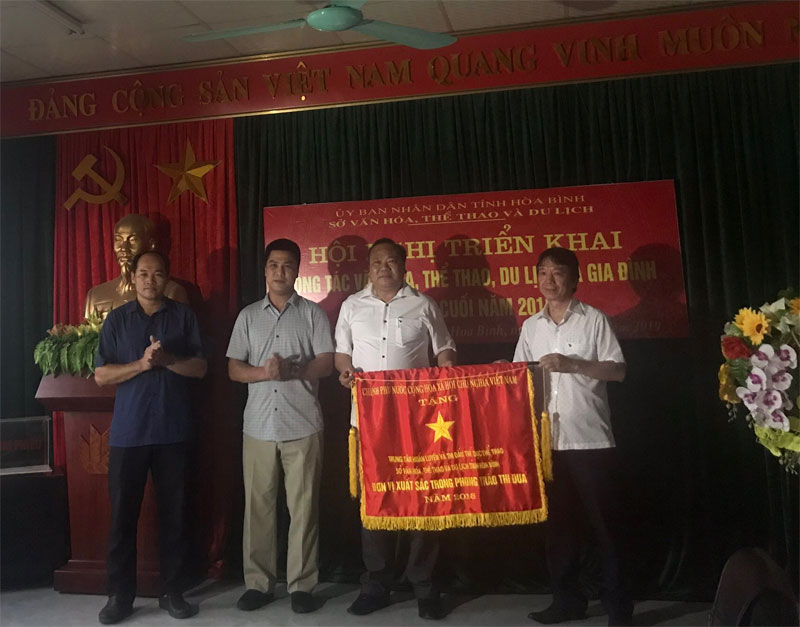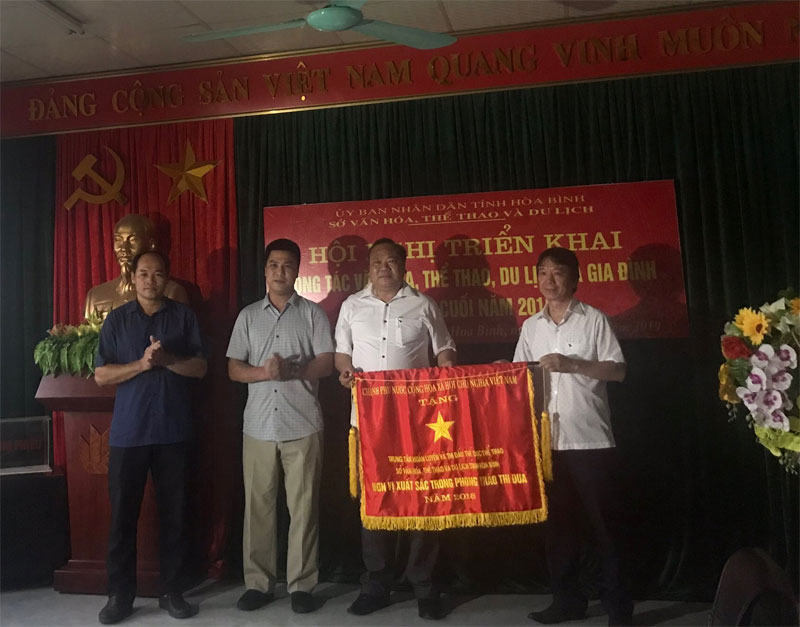
(HBO) - The Department of Culture, Sports and Tourism of Hoa Binh province has organised a conference to review the culture, sports, tourism and family work in the first half of 2019, and discuss orientations for implementing the work in the second half.
 A representative from the provincial
Department of Culture, Sports and Tourism presents the flag of the Government
to the physical training and sport centre - the outstanding unit in emulation movements
in 2018.
A representative from the provincial
Department of Culture, Sports and Tourism presents the flag of the Government
to the physical training and sport centre - the outstanding unit in emulation movements
in 2018.
In the first six months of 2019, the provincial Department of
Culture, Sports and Tourism has actively given advices to the provincial
People's Committee and the Steering Committees to build, issue and organize the
implementation of projects, decisions and work plans in the field of culture,
sports, tourism and family in the locality.
The department maintains the opening of the heritage showroom
"Typical cultural heritage of Muong Hoa Binh ethnic group". It also successfully
organised three provincial sports tournaments, while instructing districts and
city to organize 39 sports events.
It submitted the project "restructuring tourism sector to develop tourism into key
economic sector” to the Provincial People's Committee.
A photo contest to promote Hoa Binh Reservoir tourism area in 2019 was held.
The locality is estimated to receive 2.05 million tourists in the reviewed
period, earning 1.2 trillion VND, equivalent to 68 percent and 60 percent of
the plan set for the year, respectively.
Participants also discussed orientations for implementing the work in the last
six months of the year, focusing on organising the Culture-Tourism Week of Hoa
Binh province in 2019; building an art programme to join relevant cultural
festivals and contests held by the Ministry of Culture, Sports and Tourism; and
organising provincial-level sport tournaments to select and train local
athletes for national and regional sport events.
The department will submit the
project "Community-based tourism development in Hoa Binh to 2030” to the
provincial People’s Committee for approval and implementation, and arrange activities
to foster moral education and lifestyle in Vietnamese families in the locality associated with the implementation of
Directive No. 11/CT-TTg dated March 29, 2017 by the Prime Minister on promoting
moral education and family lifestyle.
With an increasingly vibrant and widespread emulation movement aimed at building cultured residential areas and cultured families, Yen Thuy District has been making steady progress toward improving both the material and spiritual well-being of its people, while fostering a civilized, prosperous, beautiful, and progressive community.
Once lacking recreational spaces and community facilities, Residential Group 2 in Quynh Lam Ward (Hoa Binh City) has recently received attention for the construction of a new, spacious, and fully equipped cultural house. The project followed the model of state support combined with public contributions in both labor and funding.
The "All people unite to build cultural life" movement, which has been effectively integrated with Kim Boi district’s socio-economic development goals, is fostering a lively spirit of emulation across local residential areas, hamlets, villages, public agencies, and enterprises. In addition, through the initiative, traditional cultural values are being preserved and promoted, while community solidarity and mutual support in poverty reduction and economic development are being strengthened.
A working delegation of the Hoa Binh provincial People’s Committee led by its Permanent Vice Chairman Nguyen Van Toan on June 11 inspected the progress of a project to build the Mo Muong Cultural Heritage Conservation Space linked to tourism services in Hop Phong commune, Cao Phong district.
Born and growing in the heroic land of Muong Dong, Dinh Thi Kieu Dung, a resident in Bo town of Kim Boi district, in her childhood was nurtured by the sweet lullabies of her grandmother and mother. These melodies deeply imprinted on her soul, becoming an inseparable part of her love for her ethnic group's culture. For over 20 years, this love for her hometown has driven Dung to research, collect, and pass down the cultural values of the Muong people to future generations.
In the final days of May, the Ethnic Art Troupe of Hoa Binh Province organized performances to serve the people in remote, mountainous, and particularly disadvantaged areas within the province. These were not just ordinary artistic shows, but they were the meaningful journeys aimed at spreading cultural values, enhancing the spiritual life of the people and contributing to the preservation of ethnic minority cultural identities.



 A representative from the provincial
Department of Culture, Sports and Tourism presents the flag of the Government
to the physical training and sport centre - the outstanding unit in emulation movements
in 2018.
A representative from the provincial
Department of Culture, Sports and Tourism presents the flag of the Government
to the physical training and sport centre - the outstanding unit in emulation movements
in 2018.